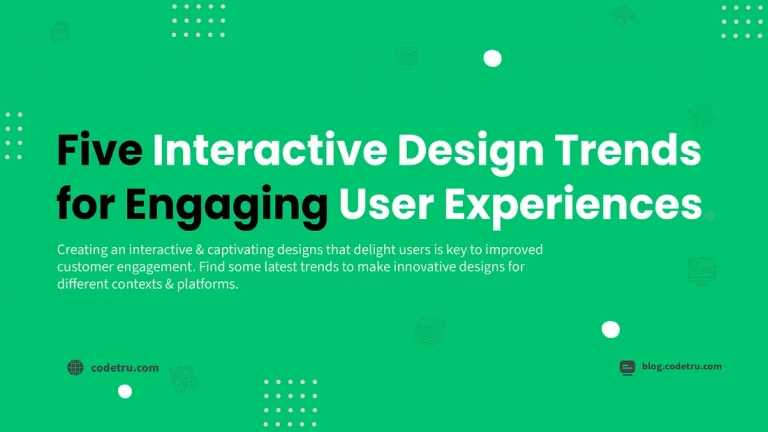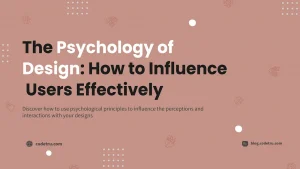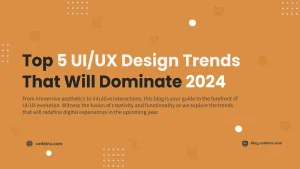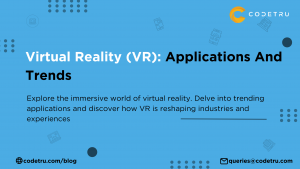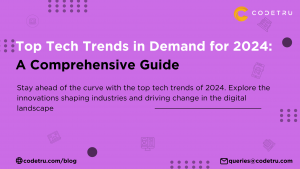Embarking on a journey through the ever-evolving world of interactive design, this exploration unravels the threads of emerging trends that redefine user experiences. From animated product reveals to immersive 3D worlds, each trend encapsulates a facet of digital evolution, promising not just engagement but a complete reimagining of how users interact within the digital realm.
Interactive design is the art of creating digital products that respond to the user’s actions and inputs, such as clicks, taps, swipes, scrolls, etc. It is essential for creating user-friendly and memorable digital products, as it enhances the usability, functionality, and aesthetics of the user interface (UI).
Some examples of interactive design elements are animations, transitions, hover effects, sound effects, etc. These elements can add life and personality to the UI, and create a more engaging and immersive user experience (UX).
In this blog post, we will explore the emerging trends in interactive design and how they can be leveraged to create engaging and immersive user experiences. We will look at some of the latest and most innovative examples of interactive design in action, and provide some tips and best practices for applying them to your own projects.
Trend 1: Animated Product Reveals
Animated product reveals breathe life into digital interfaces, employing dynamic unveilings triggered by user interactions. It involves gradually revealing a product or its features to the user as they interact with the UI. For example, using hover effects or other interactions to unveil a product image, a product description, a product video, etc.
Animated product reveals can have several benefits for user engagement, such as:
- Simplifying the UI and reducing clutter: By hiding the non-essential information or features until the user requests them, animated product reveals can create a cleaner and more focused UI.
- Improving usability and learnability: By providing the user with feedback and guidance on how to use the product or its features, animated product reveals can improve the user’s understanding and confidence.
- Reducing errors and confusion: By preventing the user from accessing the wrong or irrelevant information or features, animated product reveals can reduce the user’s frustration and mistakes.
- Increasing user satisfaction and curiosity: By creating a sense of discovery and surprise, animated product reveals can increase the user’s interest and enjoyment.
Some examples of animated product reveals in action are:
- Simply Chocolate: This website uses hover effects to reveal the product images and descriptions of different chocolate bars in a mouth-watering way.
- Icam: This website also uses hover effects to reveal the product features and benefits of different cameras in a sleek and elegant way.
- Volvo: This website uses scroll effects to reveal the product details and specifications of different cars in a dynamic and immersive way.
Trend 2: Immersive 3D Worlds
Immersive 3D worlds are a UX design technique that involves using 3D graphics, animations, and interactions to create realistic and captivating environments that the user can explore and interact with. It transcend flat screens, utilizing 3D graphics and interactions to create lifelike digital environments.
The appeal of immersive 3D lies in its ability to stimulate the senses, offering users a richer, more profound interaction with digital content. The freedom to explore these realistic environments adds a layer of engagement that traditional interfaces lack.
Brands and creators such as Orb Space, Bruno Simon, and The Cool Club redefine visual storytelling by providing users with an immersive experience beyond conventional boundaries.
For example, using 3D models, textures, lighting, shadows, etc. to create a virtual reality (VR) or augmented reality (AR) experience.
Immersive 3D worlds can have several benefits for user engagement, such as:
- Enhancing the visual appeal: By creating a stunning and realistic 3D representation of the product or the brand, immersive 3D worlds can attract and retain the user’s attention.
- Creating a sense of presence and immersion: By allowing the user to navigate and manipulate the 3D environment, immersive 3D worlds can create a feeling of being there and being part of the story.
- Stimulating the senses and emotions: By providing the user with sensory and emotional feedback, such as sound, touch, motion, etc., immersive 3D worlds can create a more engaging and memorable experience.
- Offering more possibilities and freedom: By providing the user with more options and choices, immersive 3D worlds can create a more personalized and customized experience.
Trend 3: Overstimulation
Overstimulation is a UX design technique that involves using bright colors, bold fonts, chaotic layouts, and fast-paced animations to create a visually intense and overwhelming experience that challenges the user’s attention and perception.
Overstimulation challenges conventional design norms, employing bright colors, bold fonts, and chaotic layouts to create visually intense experiences.
Contrary to expectations, overstimulation isn’t just a visual spectacle; it’s a strategic approach to capturing and retaining user attention. It becomes a unique expression of a brand’s personality, leaving a lasting impression on users.
For example, neon colors, glitch effects, distorted sounds, etc. are used to create a psychedelic or dystopian experience.
Overstimulation can have several benefits for user engagement, such as:
- Attracting and retaining the user’s attention: By creating a striking and unique visual impression, overstimulation can capture and hold the user’s attention.
- Creating a unique and memorable impression: By creating a distinctive and unconventional visual identity, overstimulation can make the product or the brand stand out from the crowd.
- Expressing the brand’s personality and identity: By creating a bold and expressive visual style, overstimulation can convey the brand’s message and values.
- Evoking emotions and reactions: By creating a provocative and controversial visual experience, overstimulation can elicit the user’s emotions and opinions.
Some examples of overstimulation in action are:
- Gucci: The International luxury fasion house uses bright colors, bold fonts, chaotic layouts, and fast-paced animations to create a vibrant and eclectic experience that reflects the brand’s quick adopting fashion and culture.
- The Year of Greta: This website focusing on highlighting Greta Thunberg’s work uses neon colors, glitch effects, distorted sounds, and fast-paced animations to create a psychedelic and dystopian experience that highlights the environmental and social issues of the year 2020.
Trend 4: Parallax Zoom Scrolling
Parallax zoom scrolling is a UX design technique that involves using different scrolling speeds and directions for different layers of the page to create a zooming effect that simulates depth and perspective. For example, using faster scrolling for the foreground elements and slower scrolling for the background elements to create a 3D effect.
This trend goes beyond visual appeal; it actively contributes to storytelling by emphasizing crucial details and creating a more engaging narrative. Users aren’t just navigating; they are an integral part of the unfolding story.
Parallax zoom scrolling can have several benefits for user engagement, such as:
- Creating a dynamic and interactive experience: By creating a sense of motion and animation, parallax zoom scrolling can make the page more lively and responsive.
- Enhancing the storytelling and narrative: By creating a sense of progression and transition, parallax zoom scrolling can make the page more coherent and compelling.
- Adding visual interest and variety: By creating a sense of depth and perspective, it makes the page more attractive and diverse.
- Highlighting the important elements and details: By creating a sense of focus and emphasis, parallax zoom scrolling can make the page more clear and informative.
Some examples of parallax zoom scrolling in action are:
- Apple: Apple uses parallax zoom scrolling to create a stunning and immersive experience that showcases the features and benefits of the latest launches
- Netflix: Netflix uses a combination of UX practices to showcase the trailers and reviews of the latest movies and shows.
- Spotify: Spotify uses dynamic and engaging experience that showcases the playlists and podcasts of the most popular artists and genres.
Trend 5: ’90s Navigation
Beyond nostalgia, ’90s navigation injects a dose of creativity and originality into the digital space. It’s a departure from sleek, modern designs, offering users a playful and unique journey through the digital landscape.
’90s navigation involves using retro-style elements, such as pixelated graphics, neon colors, cursor trails, and sound effects, to create a nostalgic and playful experience that mimics the early days of the web. For example, using 8-bit graphics, rainbow colors, mouse pointers, and MIDI sounds to create a vintage or retro experience.
’90s navigation can have several benefits for user engagement, such as:
- Appealing to the user’s nostalgia and curiosity: By creating a familiar and nostalgic experience, ’90s navigation can appeal to the user’s emotions and memories.
- Creating a contrast and novelty: By creating a different and unexpected experience, ’90s navigation can create a sense of surprise and delight.
- Adding humor and fun: By creating a humorous and playful experience, ’90s navigation can create a sense of fun and enjoyment.
- Expressing the brand’s creativity and originality: By creating a creative and original experience, ’90s navigation can convey the brand’s personality and identity.
Some examples of ’90s navigation in action are:
- Space Jam and Windows 93 uses pixelated graphics, neon colors, cursor trails, and sound effects to create a nostalgic and playful experience.
Conclusion
It’s evident that interactive design trends aren’t merely surface-level embellishments but integral components shaping the future of digital interaction. From dynamic animations to immersive environments, these trends promise a redefined user experience that transcends traditional boundaries, offering a glimpse into the boundless possibilities of tomorrow’s digital landscape.
FAQs on Interactive Design Trends
1. What are the latest interactive design trends for enhancing user engagement?
The latest interactive design trends include immersive experiences with augmented reality (AR), micro-interactions that provide instant feedback, personalized content driven by user behavior, conversational interfaces such as chatbots, and dynamic animations that capture user attention. These trends help create engaging and memorable experiences by making interactions more intuitive and responsive.
2. How can augmented reality (AR) improve user experience in interactive design?
Augmented reality (AR) enhances user experience in interactive design by blending digital elements with the real world, creating immersive and interactive environments. AR allows users to visualize products in their own space, interact with virtual objects, and engage with content in a more intuitive way. This technology can significantly boost engagement and provide a more compelling experience.
3. What role do micro-interactions play in modern interactive design?
Micro-interactions are subtle animations or responses triggered by user actions, such as button clicks or form submissions. They play a crucial role in modern interactive design by providing immediate feedback, guiding users through processes, and making the overall experience more engaging. These small details can enhance usability and make interactions feel more fluid and satisfying.
4. How can personalized content impact user engagement in interactive design?
Personalized content can significantly impact user engagement by tailoring experiences to individual preferences and behaviors. By analyzing user data and interactions, designers can create custom content, recommendations, and user interfaces that resonate with each user. This personalization increases relevance, satisfaction, and overall engagement by making users feel valued and understood.
5. What are the benefits of using conversational interfaces like chatbots in interactive design?
Conversational interfaces such as chatbots provide several benefits in interactive design. They offer users a more natural and intuitive way to interact with applications by simulating human-like conversations. Chatbots can assist with customer support, answer queries, and guide users through tasks, enhancing engagement and providing instant assistance without the need for complex navigation.

